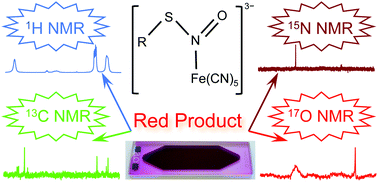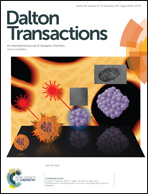Direct NMR detection of the unstable “red product” from the reaction between nitroprusside and 2-mercaptosuccinic acid†
Abstract
The reaction between nitroprusside (NP, [FeII(CN)5NO]2−) and organic thiolates (RS−) in aqueous solution has long been known to produce an unstable red intermediate thus often being referred to as the “red product” (RP) in the literature. While RP has always been formulated as [FeII(CN)5N(O)SR]3−, it is rather difficult to study it in aqueous solution because it is not only unstable but also exhibits rapid ligand exchange. All previous studies of RP have relied on UV-vis, IR, kinetics measurements, and analysis of decomposed products. Herein we report the first comprehensive multinuclear (1H, 13C, 15N, and 17O) NMR characterization of the RP produced from the reaction between NP and 2-mercaptosuccinic acid (MSA). The NMR chemical shifts obtained for the RP are compared with those from the free ligand (S-nitrosothiol, RS–N![[double bond, length as m-dash]](https://www.rsc.org/images/entities/char_e001.gif) O) prepared in situ by the reaction of MSA with NaNO2. We also showed that useful thermodynamic and kinetic properties of RP formation can be readily obtained from 1H NMR studies.
O) prepared in situ by the reaction of MSA with NaNO2. We also showed that useful thermodynamic and kinetic properties of RP formation can be readily obtained from 1H NMR studies.


 Please wait while we load your content...
Please wait while we load your content...